Odds & Ends: Modern Horizons 2, Part 2
Last week, Aaron Forsythe and I started answering your questions about Modern Horizons 2. There were so many questions, we decided to spend a second week answering them. I've noted Aaron's answers so it's clear who's answering.
That said, let's start with a question for Aaron:
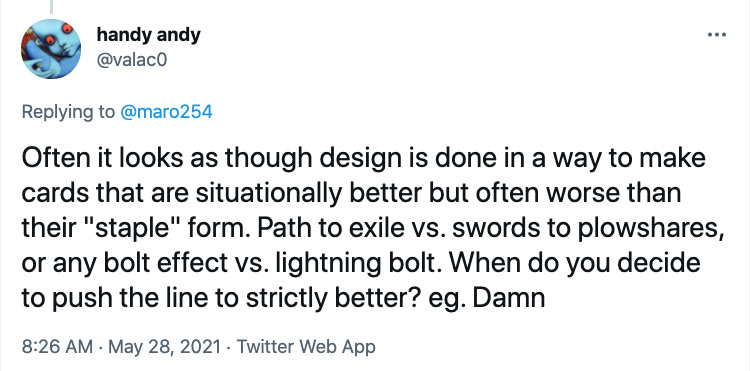
Aaron: We usually try to avoid making strictly better versions of tournament-playable cards. We either like to make "sidegrades" that have situational use cases to make for interesting choices, or we make a better version of a card or effect that isn't seeing play to make it good enough.
The card Damn is a bit of an outlier there. It lives and dies on the costs of the effects—if it overloads for something other than 2WW, the Wrath of God reference is lost. We had quite a few debates about the card internally, but it always was in first place when we focus-tested the rares both internally and externally—it's such a satisfying holistic package—that we really wanted to print it. Luckily, cards like Spell Snare, Inquisition of Kozilek, and Eidolon of the Great Revel mean you shouldn't be playing Damn over Wrath of God in Modern in decks that can't make black mana and that there are situations where it will be worse even when you can.
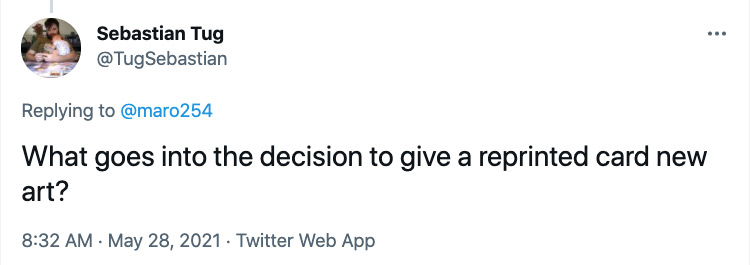
The short answer is that it's the art director's call. For the longer answer, let me explain how the system works.
Each set has an art budget (i.e., a certain number of cards can get new art), and the art director gets to choose how to spend it. Obviously, new cards must get new art, but that usually doesn't use up the whole budget.
When reprinting cards, the art director will look at every piece of art available for the card. Sometimes it will have art that much of the audience hasn't seen—for example, maybe we made art for a promo or for a digital use that's never been released before in a booster pack—and the art director will lean toward using art that might excite players. Sometimes the art is very iconic, and the art director wants to bring back the art they know will make old-timers happy to see again.
Other times, though, the art director might decide it's time to try something new or maybe tie this card into something else connected with the set. It's more of a subjective call than anything else, but it comes from trying to make the art the best that it can be.
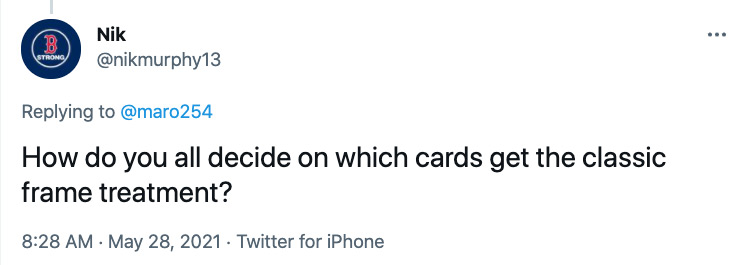
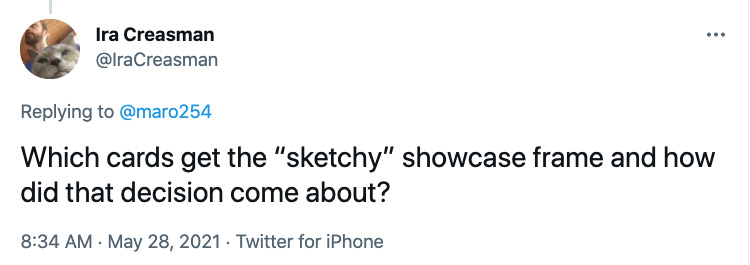
I'll let Aaron answer both questions.
Aaron: In most normal sets, we apply the showcase treatments to cards with a consistent mechanical theme. All the landfall creatures in Zendikar Rising get hedron frames; all the mutate creatures in Ikoria: Lair of Behemoths get the showcase comic treatment.
Modern Horizons 2 lacks any kind of mechanical density, so the card choices for special treatments was ad hoc. I chose cards that felt "old school" for the retro frame treatment (and made sure the four new-to-Modern reprints that never had old frames got them), and I worked with Art Director Cynthia Sheppard to find cards with distinct sketches that would look good in the showcase sketch frame.
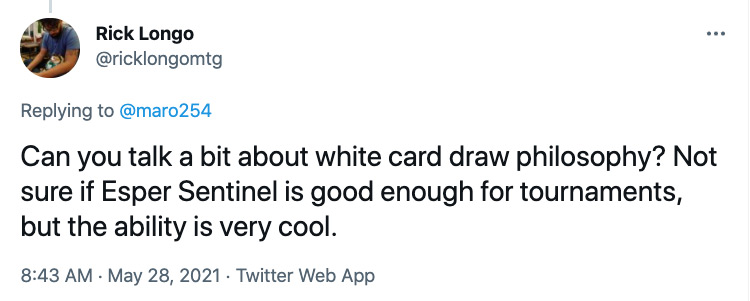
We spent a lot of time on the Council of Colors, figuring out how to give white card drawing a feel unique to white. Our goal wasn't to just take existing card-drawing spells and make them white but rather carve out some new space for card drawing that got to be part of white's identity. The work isn't about making only one thing but a series of things that will come together cohesively to create the feel we want. We're not even sure which pieces will work out best, so we're trying a bunch of different things. As they come up, I'll walk you through them.
Esper Sentinel is us trying card draw as a means of a tax. Clearly, white can set rules, so what if white sets rules but lets players buy their way out of the effect by letting the white player who created the rule draw cards? This isn't something any other color is doing and feels very white. I'm optimistic of this design space and hope people enjoy Esper Sentinel.
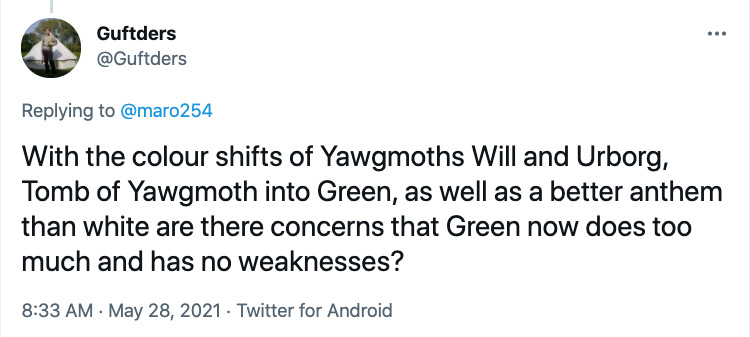
I'm going to let Aaron answer first, then I'm going to answer.
Aaron: I've seen a lot of consternation about green stealing stuff from other colors in Modern Horizons 2. I'll address the three big ones.
- Gaea's Will. Just because Yawgmoth's Will is famously powerful doesn't mean its effect is black. In fact, when Mark first submitted the card back in Urza's Saga, it was green. Getting your whole graveyard back is a green ability, and this card isn't nearly as powerful as its namesake, so I don't think this card shifts the balance of color power very much at all.
- Yavimaya, Cradle of Growth. I don't think "all your lands are a type" is something black has any kind of monopoly on. Forests spreading to cover everything is great flavor, and green having access to this effect will play out very differently than black having it (green doesn't have cards like Cabal Coffers or Corrupt). Mirroring cards across colors that lead to very different outcomes is cool.
- Sylvan Anthem. This is one that goes too far. After the set was locked down, the Council of Colors deemed this one to be too far out of bounds. White should have the best "Anthem" effects, and this is likely to the be the best one in Modern. If I could go back in time, I'd find a different reward than +1/+1.
Mark: There are two different issues with green: weakness undermining and overall color balance. Let me first address undermining its weakness. Each of the three cards Aaron walked through above are in areas of things green can do (getting cards out of graveyards, getting mana, and boosting creatures). There are some rate issues to talk about (how good the effect is versus its mana value), but none of those cards is letting green do something it shouldn't be doing color pie-wise, and it's not allowing green to do something that offsets its weakness (i.e., its overreliance on creatures). So, I don't believe us undermining green's weakness in Modern Horizons 2 is a worry.
Now, let's talk color balance. As I often say, Magic is more than just one game, it's a game system connected by a shared set of rules and game components. We try hard to balance the colors the best we can, but there are a couple obstacles.
One, it's just a tricky thing to do with so many interconnected pieces. We tend to address this by having colors ebb and flow, meaning what color is best changes as new sets come out.
Two, there are a lot of formats. The bigger the format, the more difficult it is for us to color balance. For example, there's a decent chance we can color balance a particular Limited environment, but it's near impossible to color balance Eternal formats. Adding new cards to a 28-year card history can only make so big of an impact, and we want to be judicious with how often we ban cards.
So, why don't we just make strong cards in certain colors and fewer in others (over a longer period of time) to balance all of Magic? That would cause all sorts of problems in other formats without even a guarantee that it would color balance Eternal formats. On top of that, between color pie evolution and color breaks that, in retrospect, we wouldn't have made, the color pie is already very stretched out in larger formats, so I believe it would be an unattainable task even if we tried.
I do want to stress, as I did above in the last question, that we do track areas we need to think about color pie-wise, such as white in Commander, and actively work to make cards that can function as new tools for various environments. We might not be able to balance white with green in Commander, but we can give white access to new things that might encourage Commander players to try it out in decks.
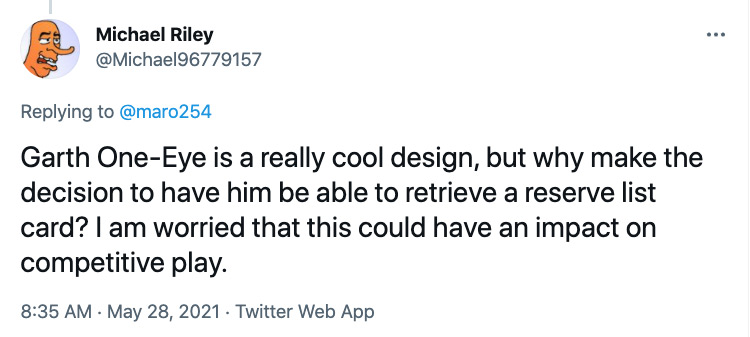
Another question for Aaron.
Aaron: The cool part of the design is that you don't need to physically own the Reserved List cards (Braingeyser and Black Lotus) to get to enjoy them—Garth creates copies, and you get to play the copies! Our testing showed this not to be unbalanced for tournament play and instead just a fun way to experience some of the old bits of Magic's past.

Myr are currently just a New Phyrexia (formerly Mirrodin) thing. Supplemental sets like Modern Horizons 2 can often pull from multiple worlds, so it lets us do things like including Myr. If we ever find another world where Myr might make sense, it's something we would consider, but sadly (I'm a Myr fan and would love to see more), they are currently a one-plane creature type.
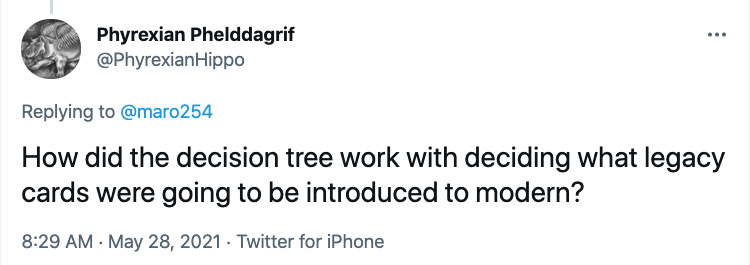
This is another question for Aaron.
Aaron: I worked with the Play Design team to rate hundreds of cards that weren't Modern legal to determine which would be good fits for the format now, which might be good for some time in the future, which we should never introduce, and which were unlikely to matter at all. I looked mostly at the first bucket (and a little at the second and fourth) and found a bunch cards that fit our Limited themes and/or that players had been asking for, and/or that I personally have fond memories of playing with. We tested them all and had to cut some (like Doomsday), but overall, I think we ended up with a spicy batch of reprints being added to the format.
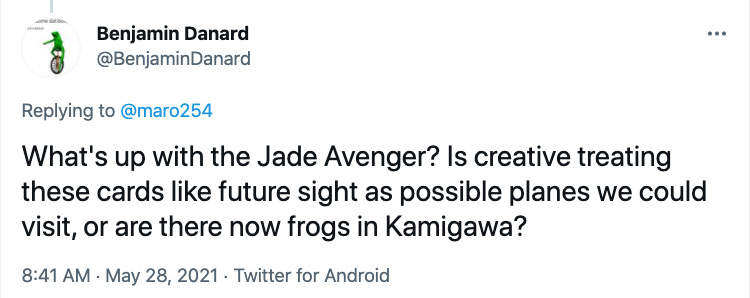
Part of the freedom of a set not centered on a particular world is that we can play around more on individual card concepts. The whole point of Jade Avenger was to have a Frog Samurai (let Chub Toad finally get bushido). We had the freedom to just make the card we wanted and didn't have to worry about where it came from. To be honest, I don't know if we know what world Jade Avenger is from. I don't think it's Kamigawa, but I doubt it was created as being definitively from a known plane.
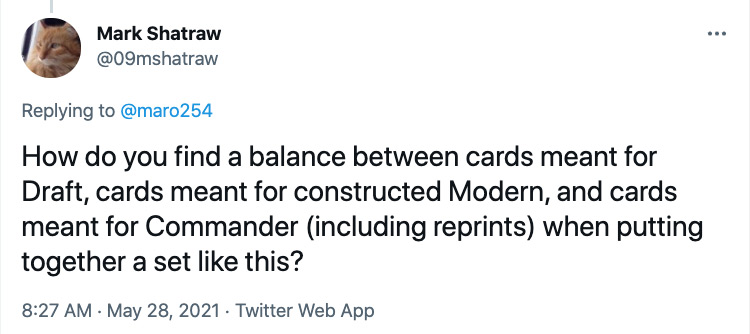
The key to designing for Booster Draft (and Limited formats in general) is to focus primarily on common and uncommon cards, because the format is built around as-fans of mechanics and themes (i.e., what percentages certain things will show up in booster packs). Rares and mythic rares can add some spice to Draft, and the occasional fun build-around card, but it's the commons and uncommons that do the lion's share of making Draft work. Mechanics and themes must show up in enough volume that players can draft them and build cohesive decks.
The key to designing Constructed Modern cards is studying Modern and recognizing where there are areas for potential. There are a few major ways to do this:
- You can find existing decks and create cards that slot into those decks.
- You can create powerful cards that allow a deck to be built around it.
- You can make cards that bridge together subthemes.
Note, in all three categories, you can make cards that do things using known effects, or you can design new effects. The former is much easier than the latter. In Modern Horizons 2, this required a lot of playtesting, including bringing in some pro players to playtest so we could see if certain cards were filling any of the above functions.
The key to designing Commander cards is finding cards that have effects that lean toward being relevant in Commander. Commander is slower in general, and certain resources, like getting access to cards and mana, become more important.
Also, because the format revolves around commanders, you always want to design your legendary creatures with an eye on Commander. (I should stress that not all legendary creatures are made specifically for Commander, though.) We have a whole team dedicated to making Commander, so we can turn to them as a resource when making sets (and often members of that team are on design teams).
There are definite overlaps between these categories, so it's possible to make a card relevant in multiple formats. It's important when designing a card to understand what formats a card would be most relevant in and lean in that direction.
The final question of the day is for Aaron:
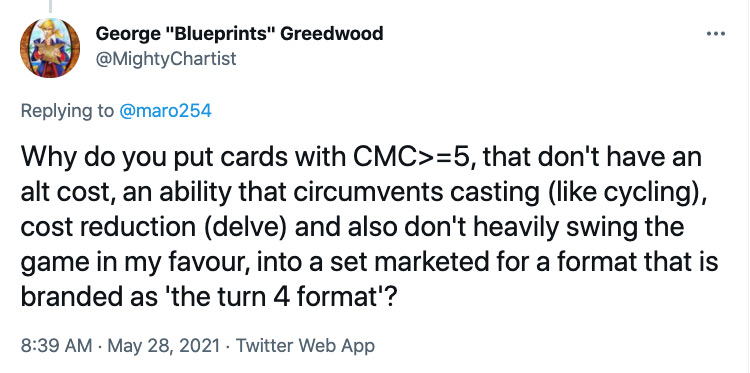
Aaron: There are a lot of ways to answer this.
- The "Modern" in Modern Horizons doesn't necessarily mean "competitive cutthroat Modern." Many people play Modern at home or in stores using sweet homebrew decks that result in games going longer than turn four all the time.
- We couldn't possibly power up the whole set to have an impact in a turn-four Modern metagame. No one would be happy with that.
- Limited and Commander players are a huge part of the audience for this product, and it's nice to be able to have different places to aim cards.
- Even in cutthroat Modern, some cards with mana value 5 or more appear regularly, like Teferi, Hero of Dominaria and Primeval Titan. You can try to slow the game down or ramp your mana to make these cards playable.
- We did put cost reduction or cycling on a lot of our expensive cards and filled the set with reanimator effects that should make even creatures of mana value 7 or greater more enticing.
The set caters to a huge swath of players and experiences. Cutthroat Modern will get a ton of new toys from this product, and we hope fans of Commander, Pauper, Legacy, Vintage, and Limited all find plenty of things to get excited about as well.
"And. . . done."
That's all the time we have for today. I'd like to thank everyone who sent in questions and Aaron for helping me answer them. As always, if you have any feedback about either my or Aaron's answers, you can email me with feedback or contact me through any of my social media accounts (Twitter, Tumblr, Instagram, and TikTok). If you enjoy having me answer your questions, please feel free to visit my Tumblr, as I answer questions there every day.
Join me next week when Dungeons & Dragons: Adventures in the Forgotten Realms previews begin.
Until then, may you play more Modern Horizons 2 so you can come up with even more questions.
#845: Modern Horizons with Mark Globus
#845: Modern Horizons with Mark Globus
I sit down with former R&D member Mark Globus to talk about the making of the original Modern Horizons.
#846: Planeswalkers, Part 3
#846: Planeswalkers, Part 3
30:47
This podcast is part three of a three-part series where I discuss every Planeswalker ever made into a planeswalker card.
- Episode 844 Tempest Story, Part 2
- Episode 843 Tempest Story, Part 1
- Episode 842 Planeswalkers, Part 2

